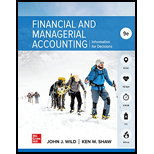
a.
An accounting equation is formed by three main elements, namely, asset account, liability account and equity account. The formation is done as: Assets = Liabilities + Equity.
Every business transaction can be identified and analyzed through this accounting equation for the purpose of further analyzing the effects of each such transaction on the asset, liability and equity.
To compute: Income or loss, if common stock of $3,000 was issued and dividends amounting to $7,000 was paid during the current year.
b.
Accounting Equation:
An accounting equation is formed by three main elements, namely, asset account, liability account and equity account. The formation is done as: Assets = Liabilities + Equity.
Every business transaction can be identified and analyzed through this accounting equation for the purpose of further analyzing the effects of each such transaction on the asset, liability and equity.
To compute: Income or loss, if additional common stock of $15,000 was issued and no dividends were paid during the year
c.
Accounting Equation:
An accounting equation is formed by three main elements, namely, asset account, liability account and equity account. The formation is done as: Assets = Liabilities + Equity.
Every business transaction can be identified and analyzed through this accounting equation for the purpose of further analyzing the effects of each such transaction on the asset, liability and equity.
To compute: Income or loss, if no additional common stock was issued and no dividends of $12,000 were paid during the year
Want to see the full answer?
Check out a sample textbook solution
Chapter 1 Solutions
Financial and Managerial Accounting
- What is the return on equity? General accountingarrow_forwardHi expert please help me this questionarrow_forwardConsider the following accounts and identify each account as an asset (A), liability (L). or equity (E). a. Notes receivable. b. Common stock. c. Prepaid insurance. d. Notes payable. e. Rent revenue. f. Taxes payable. g. Rent expense. h. Furniture. i. Dividends. j. Unearned revenue.arrow_forward
- Which of the following is a manufacturing product cost? a. Depreciation on factory equipment b. Sales commissions c. Cost to repair manufacturing machinery d. All are product costs. e. Both a and c are product costs.arrow_forwardPlease given correct answer general accountingarrow_forward3 PTSarrow_forward
- General accountingarrow_forwardAnswer? ? Financial accounting questionarrow_forwardUltimate Production manufactures radon detectors. The standard for materials for each detector is 2 pounds of acrylic at a standard cost of $4.30 per pound. During May, the company purchased 890 pounds and used 830 pounds of acrylic, and made 410 radon detectors. The company paid $4.45 per pound for the acrylic. There were 400 detectors budgeted for May. How much is the material price variance? A) $134 unfavorable. B) $43 unfavorable. C) $177 unfavorable. D) $263 unfavorable.arrow_forward
 Managerial AccountingAccountingISBN:9781337912020Author:Carl Warren, Ph.d. Cma William B. TaylerPublisher:South-Western College Pub
Managerial AccountingAccountingISBN:9781337912020Author:Carl Warren, Ph.d. Cma William B. TaylerPublisher:South-Western College Pub Financial And Managerial AccountingAccountingISBN:9781337902663Author:WARREN, Carl S.Publisher:Cengage Learning,
Financial And Managerial AccountingAccountingISBN:9781337902663Author:WARREN, Carl S.Publisher:Cengage Learning, Managerial Accounting: The Cornerstone of Busines...AccountingISBN:9781337115773Author:Maryanne M. Mowen, Don R. Hansen, Dan L. HeitgerPublisher:Cengage Learning
Managerial Accounting: The Cornerstone of Busines...AccountingISBN:9781337115773Author:Maryanne M. Mowen, Don R. Hansen, Dan L. HeitgerPublisher:Cengage Learning Intermediate Accounting: Reporting And AnalysisAccountingISBN:9781337788281Author:James M. Wahlen, Jefferson P. Jones, Donald PagachPublisher:Cengage Learning
Intermediate Accounting: Reporting And AnalysisAccountingISBN:9781337788281Author:James M. Wahlen, Jefferson P. Jones, Donald PagachPublisher:Cengage Learning Survey of Accounting (Accounting I)AccountingISBN:9781305961883Author:Carl WarrenPublisher:Cengage Learning
Survey of Accounting (Accounting I)AccountingISBN:9781305961883Author:Carl WarrenPublisher:Cengage Learning Financial AccountingAccountingISBN:9781337272124Author:Carl Warren, James M. Reeve, Jonathan DuchacPublisher:Cengage Learning
Financial AccountingAccountingISBN:9781337272124Author:Carl Warren, James M. Reeve, Jonathan DuchacPublisher:Cengage Learning





